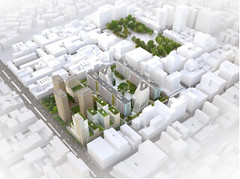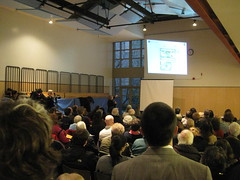 Courtesy of N.Y.U. An illustration of a revised development plan by N.Y.U., which includes the construction of a new 14-story building at Bleecker Street and LaGuardia Place.
Courtesy of N.Y.U. An illustration of a revised development plan by N.Y.U., which includes the construction of a new 14-story building at Bleecker Street and LaGuardia Place.At a crowded public meeting in Grace Church’s Tuttle Hall Monday night, Greenwich Village greeted New York University’s revised core expansion plan with its own version of a Bronx cheer.
Since withdrawing the proposal to add a fourth tower to the landmarked Silver Towers site, the university has consistently said that it could create some 2 million square feet of new usage in the Washington Square district by developing sites it already owned. The audience seemed surprised, nevertheless, that the university had not looked elsewhere.
A slide presentation by university spokeswoman Alicia Hurley was greeted by hostile interruptions, catcalls and hisses as it became clear that the square footage lost through the cancellation of the so-called “Silver Sliver” had been redistributed to the Morton Williams supermarket site and the block-length “zipper building” on Mercer Street between Bleecker Street and West Houston.
The university has undertaken to donate the bottom seven floors of a new 14-story building at the Morton Williams location to the city for use as a public school. The rest of the building will house almost 200 university students. Existing plans for the “zipper building” have been bulked up to include the hotel development originally planned for the Silver Towers site.
Ms. Hurley said that the university’s aim was to “stay in our own footprint, which puts less pressure on the East Village and other areas you are concerned about.” The alternative to the plan, she explained, was incremental ad hoc growth in nearby districts, an approach for which the university had previously been criticized.
Community Board 2 chairwoman Jo Hamilton, in a spirited response to the presentation, described this as the “same deck of cards shuffled differently.” “The plans are too ambitious for the neighborhood,” she said. “You can’t meet your needs to grow by asking residents to sacrifice their quality of life.” Andrew Berman, executive director of the Greenwich Village Society for Historic Preservation, called for the university to look elsewhere, especially downtown.
 Kim Davis Audience members at Grace Church’s Tuttle Hall listen to a presentation Monday night by N.Y.U. spokeswoman Alicia Hurley about the revised development plan.
Kim Davis Audience members at Grace Church’s Tuttle Hall listen to a presentation Monday night by N.Y.U. spokeswoman Alicia Hurley about the revised development plan. Of the roughly 200 people in attendance, the only voices raised in support of the plan belonged to community members who were also university employees. Professor Michael Purugganan, associate director of the Center for Genomics and Systems Biology, described his department’s cancer research and work on world hunger and environmental change, insisting that limited space and facilities made it difficult to recruit the best scientists.
Janice Quinn, a local resident for three decades, and for 21 years the popular coach of the university’s women’s basketball team, was greeted with loud boos as she described crowded classrooms and the lack of adequate recreational facilities. Asked if the university had encouraged her participation in the meeting, Ms. Quinn said that she had heard objections to the plan, volunteered to speak up for it, and had been told that this meeting would be a good place to start.
Approval of the revised plan will nevertheless leave the university searching for an additional 1 million square feet in the neighborhood around the core, an area which includes the East Village. No details of where it plans to find this space have been released.
Kim Davis is the associate editor of The Local East Village.



